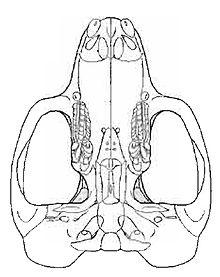| Lambdopsalis Temporal range: Upper Paleocene | |
|---|---|
 | |
| Lambdopsalis bulla - skull | |
| Scientific classification | |
| Kingdom: | Animalia |
| Phylum: | Chordata |
| Class: | Mammalia |
| Order: | †Multituberculata |
| Family: | †Lambdopsalidae |
| Genus: | †Lambdopsalis |
| Species: | †L. bulla |
| Binomial name | |
| †Lambdopsalis bulla Chow & Qi, 1978 | |
Lambdopsalis bulla is an extinct multituberculate mammal from the Late Paleocene of China and Mongolia. It is placed within the suborder Cimolodonta and is a member of the superfamily Taeniolabidoidea. Fossil remains have been found in the Late Paleocene Nomogen and Khashat Formations in Nao-mugen and Bayn Ulan of China and Mongolia.
Hair and fur fossilize very infrequently, if at all. This genus of burrowing multituberculate mammals provides one of the earliest unequivocal examples of mammal fur (Lower Cretaceous fossils of Eomaia, Volaticotherium and Castorocauda with the fur preserved still attached are currently the oldest). Indirect evidence suggest that hair first appeared on non-mammalian therapsids (Therapsida), back in the Triassic or even earlier. This is inferred from small hollows on the bone of the snout similar to holes in the skulls of cats which provide space for concentrations of nerves and blood vessels that innervate prominent whiskers (specialized hairs). This adaptation allows cats to use their whiskers as effective tactile sensory organs.
In the same Upper Paleocene strata, exceptionally preserved coprolites, originally excreted by unknown carnivorous animals, were discovered to contain undigested remains, including hair from Lambdopsalis and three other different mammal taxa.[1][2]
Studies on its tooth prism and enamel patterns have been performed. It had deciduous enamel, and there is evidence that adults and juveniles had substantially different diets.[3]
References
- ^ Meng J, Wyss AR (1997). "Multituberculate and other mammal hair recovered from Paleogene excreta". Nature. 385 (6618): 712–714. doi:10.1038/385712a0. PMID 9034186.
- ^ Novacek, Michael J. (1997). "Mammalian evolution: An early record bristling with evidence" (PDF). Current Biology. 7 (8): R489–R491. doi:10.1016/s0960-9822(06)00245-4.
- ^ Mao Fangyuan; Wang Yuanqing; Meng Jin (2015). "A Systematic Study on Tooth Enamel Microstructures of Lambdopsalis bulla (Multituberculate, Mammalia) - Implications for Multituberculate Biology and Phylogeny". PLOS ONE. 10 (5): e0128243. doi:10.1371/journal.pone.0128243. PMC 4447277. PMID 26020958.
Bibliography
- Chow & Qi (1978). "Paleocene mammalian fossils from Nomogen Formation of Inner Mongolia". Vertebrata PalAsiatica. 16 (2): 77–85.
- Kielan-Jaworowska Z., Hurum J.H. (2001). "Phylogeny and Systematics of multituberculate mammals". Palaeontology. 44 (3): 389–429. doi:10.1111/1475-4983.00185.
- Much of this information is derived from [1] MESOZOIC MAMMALS; Eucosmodontidae, Microcosmodontidae and Taeniolabidoidea, an Internet directory